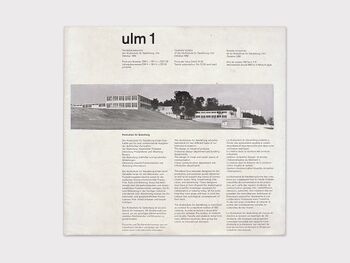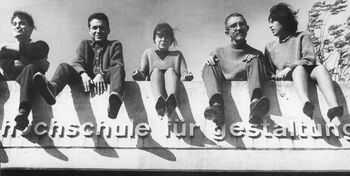Difference between revisions of "Ulm School of Design"
m (Text replacement - "http://monoskop.org" to "http://{{SERVERNAME}}") |
m (Text replacement - "sci-hub.se" to "sci-hub.st") |
||
| (14 intermediate revisions by 2 users not shown) | |||
| Line 1: | Line 1: | ||
| − | [[Image:HfG_Ulm.jpg|thumb| | + | [[Image:HfG_Ulm.jpg|thumb|350px|]] |
| − | [[Image:HfG_Ulm_Metal_workshop_1958.jpg|thumb| | + | [[Image:HfG_Ulm_Metal_workshop_1958.jpg|thumb|350px|Metal workshop at HfG Ulm, 1958.]] |
'''Hochschule für Gestaltung''' (HfG - 'School of Design') was a private school of industrial design and visual communication in Ulm, Germany, which opened in 1953 and closed in 1968. The school began as a continuation of the [[Bauhaus]] experiment under one of its former students [[Max Bill]], who headed HfG until 1956 when he resigned due to ideological conflict over the teaching programme with younger members of staff. Following Bill's departure in 1957, the school took a new direction moving away from a foundation in art towards an approach that emphasised science and society, under the leadership of [[Tomás Maldonado]], developing what came to be known as the 'Ulm model' of design. | '''Hochschule für Gestaltung''' (HfG - 'School of Design') was a private school of industrial design and visual communication in Ulm, Germany, which opened in 1953 and closed in 1968. The school began as a continuation of the [[Bauhaus]] experiment under one of its former students [[Max Bill]], who headed HfG until 1956 when he resigned due to ideological conflict over the teaching programme with younger members of staff. Following Bill's departure in 1957, the school took a new direction moving away from a foundation in art towards an approach that emphasised science and society, under the leadership of [[Tomás Maldonado]], developing what came to be known as the 'Ulm model' of design. | ||
| Line 9: | Line 9: | ||
HfG Ulm's experimental approach to teaching included the abolishment of departments as traditionally conceived within a university setting; instead disciplines were grouped around topics such as, Industrial Design, Visual Communication, Building, Information, and Film. The system of a large proportion of visiting faculty, four to every permanent member of staff, created an atmosphere of constant re-evaluation and critique, gaining HfG Ulm its reputation as a centre for cutting edge research and teaching in design. Its emphasis on the social responsibility of the designer also helped in the re-orientation of design as an inherently political activity. During the 1960s the school changed emphasis again towards theory, a move that Maldonado and Aicher opposed. The internal conflict finally led to the withdrawal of funding by the regional parliament and the school was shut down amid protests in 1968. [http://www.spatialagency.net/database/why/political/hfg.ulm (Source)] | HfG Ulm's experimental approach to teaching included the abolishment of departments as traditionally conceived within a university setting; instead disciplines were grouped around topics such as, Industrial Design, Visual Communication, Building, Information, and Film. The system of a large proportion of visiting faculty, four to every permanent member of staff, created an atmosphere of constant re-evaluation and critique, gaining HfG Ulm its reputation as a centre for cutting edge research and teaching in design. Its emphasis on the social responsibility of the designer also helped in the re-orientation of design as an inherently political activity. During the 1960s the school changed emphasis again towards theory, a move that Maldonado and Aicher opposed. The internal conflict finally led to the withdrawal of funding by the regional parliament and the school was shut down amid protests in 1968. [http://www.spatialagency.net/database/why/political/hfg.ulm (Source)] | ||
| − | [[Image:Ulm_1.jpg|thumb| | + | [[Image:Ulm_1.jpg|thumb|350px|''ulm'' 1, Oct 1958, [[ulm|PDF]].]] |
==Publications== | ==Publications== | ||
* ''[[ulm]]'', 24 numbers, 1958-68. {{de}}/{{en}}/{{fr}} | * ''[[ulm]]'', 24 numbers, 1958-68. {{de}}/{{en}}/{{fr}} | ||
| + | * [[Media:Bit_International_4_Design_1969.pdf|''Bit International'' 4: "Design / Dizajn"]], ed. Matko Meštrović, Zagreb: Galerije Grada Zagreba, 1969, 120 pp. Texts by [[Matko Meštrović]], [[Tomas Maldonado]] (3x), [[Gui Bonsiepe]] (3x), Claude Schnaidt, [[Radoslav Putar]], Vera Horvat-Pintarić, and Fedor Kritovac. {{sc}}/{{en}} | ||
* Otl Aicher, et al., ''Archithèse'' 15: "HfG Ulm: ein Rückblick. Une rétrospective", 1975. | * Otl Aicher, et al., ''Archithèse'' 15: "HfG Ulm: ein Rückblick. Une rétrospective", 1975. | ||
| − | |||
* ''Hochschule für Gestaltung Ulm: die Moral der Gegenstände'', ed. Herbert Lindinger, Berlin: Ernst, 1987, 287 pp. Exhibition catalogue. {{de}} | * ''Hochschule für Gestaltung Ulm: die Moral der Gegenstände'', ed. Herbert Lindinger, Berlin: Ernst, 1987, 287 pp. Exhibition catalogue. {{de}} | ||
| + | * Otl Aicher, ''die welt als entwurf: schriften zum design'', Berlin: Ernst & Sohn, 1991, 200 pp. {{de}} | ||
| + | ** ''The World as Design'', Berlin: Ernst & Sohn, 1994. | ||
* Gui Bonsiepe, "The Invisible Facets of the Hfg Ulm", trans. John Cullars, ''Design Issues'' 11 (1995), pp 11-20. Based on a lecture given at the Swiss Design Center Langenthal symposium ''Bauhaus, Memphis und die Folgen''. | * Gui Bonsiepe, "The Invisible Facets of the Hfg Ulm", trans. John Cullars, ''Design Issues'' 11 (1995), pp 11-20. Based on a lecture given at the Swiss Design Center Langenthal symposium ''Bauhaus, Memphis und die Folgen''. | ||
* Gui Bonsiepe, et al., ''HfG Ulm'', Berlin: form + zweck, 2003, 128 pp. With CD. {{de}} | * Gui Bonsiepe, et al., ''HfG Ulm'', Berlin: form + zweck, 2003, 128 pp. With CD. {{de}} | ||
| Line 22: | Line 24: | ||
* Kirti Trivedi (ed.), ''Readings from Ulm: Selected Articles from the Journal of the Ulm School of Design'', Mumbai: Industrial Design Centre, 1989, viii+292. [http://www.thisisdisplay.org/bookstore/readings_from_ulm] | * Kirti Trivedi (ed.), ''Readings from Ulm: Selected Articles from the Journal of the Ulm School of Design'', Mumbai: Industrial Design Centre, 1989, viii+292. [http://www.thisisdisplay.org/bookstore/readings_from_ulm] | ||
* Herbert Lindinger (ed.), ''Ulm Design: The Morality of Objects'', MIT Press, 1991. [http://services.brics.dk/java/courseadmin/DTH/documents/getDocument/Ulm_Design.pdf Part]. | * Herbert Lindinger (ed.), ''Ulm Design: The Morality of Objects'', MIT Press, 1991. [http://services.brics.dk/java/courseadmin/DTH/documents/getDocument/Ulm_Design.pdf Part]. | ||
| − | * René Spitz, ''[http:// | + | * René Spitz, ''[http://monoskop.org/log/?p=14678 The View Behind the Foreground: The Political History of the Ulm School of Design, 1953-1968]'', Stuttgart: Axel Menges, 2002. Review: [http://web.archive.org/web/20100405082752/http://agglutinations.com/archives/000017.html Blakely] (2003). |
| − | ** ''[http:// | + | ** ''[http://monoskop.org/log/?p=14678 Ein Blick hinter den Vordergrund. Die Politische Geschichte der Hochschule für Gestaltung 1953-1968]'', Stuttgart: Axel Menges, 2002. {{de}} |
* René Spitz, ''A5/06: HfG Ulm: Concise History of the Ulm School of Design'', ed. Jens Müller, Zürich: Lars Müller, 2014, 128 pp. [http://www.lars-mueller-publishers.com/en/hfg-ulm] | * René Spitz, ''A5/06: HfG Ulm: Concise History of the Ulm School of Design'', ed. Jens Müller, Zürich: Lars Müller, 2014, 128 pp. [http://www.lars-mueller-publishers.com/en/hfg-ulm] | ||
; Articles, theses | ; Articles, theses | ||
| − | * Heiner Jacob, [http://www.jstor.org.sci-hub. | + | * Heiner Jacob, [http://www.jstor.org.sci-hub.st/stable/1315712 "HfG Ulm: A Personal View of an Experiment in Democracy and Design Education"], ''Journal of Design History'' 1:3-4 (1988), pp 221-234. |
* René Spitz, [http://renespitz.de/fileadmin/redaktion/veroeffentlichungen/ReneSpitz_PolitischeGeschichteHochschuleFuerGestaltungUlm_Diss.pdf ''Die politische Geschichte der Hochschule fuer Gestaltung Ulm (1953-1968)''], 1997. Ph.D. dissertation. {{de}} | * René Spitz, [http://renespitz.de/fileadmin/redaktion/veroeffentlichungen/ReneSpitz_PolitischeGeschichteHochschuleFuerGestaltungUlm_Diss.pdf ''Die politische Geschichte der Hochschule fuer Gestaltung Ulm (1953-1968)''], 1997. Ph.D. dissertation. {{de}} | ||
* Klaus Krippendorff, [http://repository.upenn.edu/cgi/viewcontent.cgi?article=1139&context=asc_papers "Designing in Ulm and Off Ulm"], in ''HfG, Ulm. Die Abteilung Produktgestaltung. 39 Rueckblicke'', ed. K.-A. Czemper, 2008, pp 55-72. | * Klaus Krippendorff, [http://repository.upenn.edu/cgi/viewcontent.cgi?article=1139&context=asc_papers "Designing in Ulm and Off Ulm"], in ''HfG, Ulm. Die Abteilung Produktgestaltung. 39 Rueckblicke'', ed. K.-A. Czemper, 2008, pp 55-72. | ||
| Line 35: | Line 37: | ||
* Isabel Clara Neves, Joao Rocha, Jose Pinto Duarte, [http://dspace.uevora.pt/rdpc/handle/10174/13894 "The Legacy of the Hochschule fuer Gestaltung of Ulm for Computational Design Research in Architecture"], in ''Open Systems'', ed. R. Stouffs, et al., CAADRIA, 2013, pp 293-302. | * Isabel Clara Neves, Joao Rocha, Jose Pinto Duarte, [http://dspace.uevora.pt/rdpc/handle/10174/13894 "The Legacy of the Hochschule fuer Gestaltung of Ulm for Computational Design Research in Architecture"], in ''Open Systems'', ed. R. Stouffs, et al., CAADRIA, 2013, pp 293-302. | ||
* Alessandro Latela, ''[http://issuu.com/alessandrolatela/docs/tesi_issuu2 La progettazione moderna. Dal Bauhaus al modello Ulm]'', Naples: Academy of Fine Arts, 2015, 96 pp. Master's thesis. {{it}} | * Alessandro Latela, ''[http://issuu.com/alessandrolatela/docs/tesi_issuu2 La progettazione moderna. Dal Bauhaus al modello Ulm]'', Naples: Academy of Fine Arts, 2015, 96 pp. Master's thesis. {{it}} | ||
| + | * Corinna Kirsch, [https://ieeexplore.ieee.org/abstract/document/9187586 "A Three-Person Teaching Machine Designed for Crisis: The Geromat III in Berlin and Ulm"], ''IEEE Annals of the History of Computing'' 42:4 (2020), pp 39-52. | ||
==Links== | ==Links== | ||
| Line 43: | Line 46: | ||
* http://www.spatialagency.net/database/why/political/hfg.ulm | * http://www.spatialagency.net/database/why/political/hfg.ulm | ||
* http://dada.compart-bremen.de/item/institution/252 | * http://dada.compart-bremen.de/item/institution/252 | ||
| + | * [http://www.ravenrow.org/exhibition/the_ulm_model/ The Ulm Model] exhibition, Raven Row, London, 2016. | ||
{{Avant-garde art and design schools}} | {{Avant-garde art and design schools}} | ||
{{featured_article}} | {{featured_article}} | ||
Latest revision as of 08:50, 28 January 2023
Hochschule für Gestaltung (HfG - 'School of Design') was a private school of industrial design and visual communication in Ulm, Germany, which opened in 1953 and closed in 1968. The school began as a continuation of the Bauhaus experiment under one of its former students Max Bill, who headed HfG until 1956 when he resigned due to ideological conflict over the teaching programme with younger members of staff. Following Bill's departure in 1957, the school took a new direction moving away from a foundation in art towards an approach that emphasised science and society, under the leadership of Tomás Maldonado, developing what came to be known as the 'Ulm model' of design.
The short fifteen-year existence of the school had a lasting impact on design education through its use of experimental pedagogy and through creating overt relations with industry. Much of the work produced at Ulm, alongside debates taking place within the school, were disseminated in the journal, ulm, published between 1958 and 1968.
Founded in the memory of Hans and Sophie Scholl, who were executed by the Nazis as members of the resistance, HfG Ulm was established by their younger sister, Inge Scholl with Otl Aicher and others. Environmental design, as a holistic approach to human habitation, combined with political education was seen as a strategy for strengthening democratic ideals within society. Set up initially with financial support from the US and Europe, the school was later reliant on governmental funding which was never quite enough. Lecturers were obliged to make additional revenue through consultancy work with industry and this was also to prove useful for the school's pedagogical strategy. Otl Aicher introduced the model of design development which tried to bridge the gap between research and teaching. Development groups were led by staff with student assistants, working with industry partners such as Braun, developing products under market conditions. Yet these collaborations also revealed some of the contradictions underlying the Ulm philosophy, on the one hand a commitment to industrial mass production and on the other a suspicion of industry, which for the need to maximise profits did not always share Ulm's goal of design that promoted social good.
HfG Ulm's experimental approach to teaching included the abolishment of departments as traditionally conceived within a university setting; instead disciplines were grouped around topics such as, Industrial Design, Visual Communication, Building, Information, and Film. The system of a large proportion of visiting faculty, four to every permanent member of staff, created an atmosphere of constant re-evaluation and critique, gaining HfG Ulm its reputation as a centre for cutting edge research and teaching in design. Its emphasis on the social responsibility of the designer also helped in the re-orientation of design as an inherently political activity. During the 1960s the school changed emphasis again towards theory, a move that Maldonado and Aicher opposed. The internal conflict finally led to the withdrawal of funding by the regional parliament and the school was shut down amid protests in 1968. (Source)

Publications[edit]
- ulm, 24 numbers, 1958-68. (German)/(English)/(French)
- Bit International 4: "Design / Dizajn", ed. Matko Meštrović, Zagreb: Galerije Grada Zagreba, 1969, 120 pp. Texts by Matko Meštrović, Tomas Maldonado (3x), Gui Bonsiepe (3x), Claude Schnaidt, Radoslav Putar, Vera Horvat-Pintarić, and Fedor Kritovac. (Serbo-Croatian)/(English)
- Otl Aicher, et al., Archithèse 15: "HfG Ulm: ein Rückblick. Une rétrospective", 1975.
- Hochschule für Gestaltung Ulm: die Moral der Gegenstände, ed. Herbert Lindinger, Berlin: Ernst, 1987, 287 pp. Exhibition catalogue. (German)
- Otl Aicher, die welt als entwurf: schriften zum design, Berlin: Ernst & Sohn, 1991, 200 pp. (German)
- The World as Design, Berlin: Ernst & Sohn, 1994.
- Gui Bonsiepe, "The Invisible Facets of the Hfg Ulm", trans. John Cullars, Design Issues 11 (1995), pp 11-20. Based on a lecture given at the Swiss Design Center Langenthal symposium Bauhaus, Memphis und die Folgen.
- Gui Bonsiepe, et al., HfG Ulm, Berlin: form + zweck, 2003, 128 pp. With CD. (German)
Literature[edit]
- Books
- Kirti Trivedi (ed.), Readings from Ulm: Selected Articles from the Journal of the Ulm School of Design, Mumbai: Industrial Design Centre, 1989, viii+292. [1]
- Herbert Lindinger (ed.), Ulm Design: The Morality of Objects, MIT Press, 1991. Part.
- René Spitz, The View Behind the Foreground: The Political History of the Ulm School of Design, 1953-1968, Stuttgart: Axel Menges, 2002. Review: Blakely (2003).
- Ein Blick hinter den Vordergrund. Die Politische Geschichte der Hochschule für Gestaltung 1953-1968, Stuttgart: Axel Menges, 2002. (German)
- René Spitz, A5/06: HfG Ulm: Concise History of the Ulm School of Design, ed. Jens Müller, Zürich: Lars Müller, 2014, 128 pp. [2]
- Articles, theses
- Heiner Jacob, "HfG Ulm: A Personal View of an Experiment in Democracy and Design Education", Journal of Design History 1:3-4 (1988), pp 221-234.
- René Spitz, Die politische Geschichte der Hochschule fuer Gestaltung Ulm (1953-1968), 1997. Ph.D. dissertation. (German)
- Klaus Krippendorff, "Designing in Ulm and Off Ulm", in HfG, Ulm. Die Abteilung Produktgestaltung. 39 Rueckblicke, ed. K.-A. Czemper, 2008, pp 55-72.
- René Spitz, HfG IUP IFG: Ulm 1968-2008, Ulm: International Design Forum IFG Ulm, 2012, 315 pp. (German)/(English)
- Steven Heller, "The Genius That Was Ulm. An Interview with René Spitz", Print, 26 Nov 2012.
- René Spitz, "Kurze Geschichte der HfG Ulm. Das Wesentliche im Überblick", 2013. (German)
- Isabel Clara Neves, Joao Rocha, Jose Pinto Duarte, "The Legacy of the Hochschule fuer Gestaltung of Ulm for Computational Design Research in Architecture", in Open Systems, ed. R. Stouffs, et al., CAADRIA, 2013, pp 293-302.
- Alessandro Latela, La progettazione moderna. Dal Bauhaus al modello Ulm, Naples: Academy of Fine Arts, 2015, 96 pp. Master's thesis. (Italian)
- Corinna Kirsch, "A Three-Person Teaching Machine Designed for Crisis: The Geromat III in Berlin and Ulm", IEEE Annals of the History of Computing 42:4 (2020), pp 39-52.
Links[edit]
- HfG Archive, Timeline
- Women at the HfG Ulm – Curricula and Personal Histories
- c12.000 photos by Hans G. Conrad from 1953-57
- http://ulmertexte.kisd.de
- http://www.spatialagency.net/database/why/political/hfg.ulm
- http://dada.compart-bremen.de/item/institution/252
- The Ulm Model exhibition, Raven Row, London, 2016.
| Art and design schools | ||
|---|---|---|
|
Bauhaus (Weimar, Dessau, Berlin, 1919-1933), Vitebsk Popular Art Institute (Vitebsk, 1919-1922), VkHUTEMAS (Moscow, 1920-1926), School of Arts and Crafts (Bratislava, 1928-1939), Black Mountain College (Black Mountain, NC, 1933-1957), Ulm School of Design (Ulm, 1953-1968), École de recherche graphique (Brussels, est. 1972), Piet Zwart Institute (Rotterdam, est. 2001) | ||

